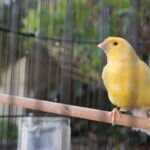Although canaries excel as singers, they’re similar to other birds in terms of other behaviors. One of the most common behaviors is a unipedal (one-legged) stance on a perch.
Tucking one leg into the feathers allows a canary to rest its tired leg and conserve warmth.
Also, it keeps one part of the body awake and alert, offering a reprieve when the other leg is sore. However, the uni-pedal stance can signify that a canary favors one of its legs due to injury.
Examine the canary closely if it stands on one foot for long periods. By identifying the cause, you can manage injuries and abnormalities, enhancing the canary’s quality of life.
Is it Normal for a Canary to Raise a Leg?
It’s normal for a canary to raise its leg. In most cases, the one-legged stance indicates that a bird needs to rest after supporting its weight for a long time.
If you notice the canary is continuously lifting one specific leg, pay close attention to understand why it happens. You may find that the behavior is caused by one or more of the following factors:
Injury
Canaries are small birds with thin legs and toes. They’re susceptible to injuries during flight, playing, or falling off their perch while asleep.
Depending on the severity and type of injury, the canary will avoid walking on the injured leg and opt to raise it most of the time. Standing on a damaged leg will be uncomfortable.
A quick examination can determine if the canary’s leg is injured. Check for swollen, misaligned, or red parts. If there are no obvious signs of injury, press the legs to gauge the canary’s reaction.
Sleeping
It is normal for canaries to sleep with one half of their brain inactive, leaving the other awake and alert. This survival mechanism allows canaries to see and escape danger.
It’s uncommon for pet canaries to sleep in a uni-pedal position.
When they do, it usually indicates fear or discomfort. It’s likely that your canary is afraid or cautious of its surroundings or hears noises at night that make it panic.
Although nothing will stop the canary from sleeping with one leg up, you can do certain things to make it more comfortable and less worried about its safety, like covering its cage at night.
This will keep it warm and prevent any scary shadows.
Muscle Fatigue
Sometimes, a canary may stand on one leg to relieve muscle fatigue on the other leg. This enables it to rest and helps conserve energy.
Research on muscle fatigue reduction in canaries is scant. A study by Biology Letters found that ostriches exhibit the one-legged posture as much as canaries.
This study found that canaries may use less energy standing on one leg than in the two-legged position. Given that food is scarce at certain times, reduced energy consumption is invaluable.

Temperature Regulation
Canaries have various adaptations that help them survive in harsh environments.
For instance, they fluff their feathers during cold temperatures to trap air pockets or shiver more often to increase metabolic activities, thus generating more heat.
Moreover, they can constrict blood vessels in their legs, thus reducing blood flow. Only a small amount of heat is lost. The legs are also covered with thick scales, which defend against the cold.
Despite all these survival mechanisms, canaries still lose heat through their legs, particularly on frigid days. Most canaries keep one leg close to the feathers to keep it warm.
It’s not only normal for your canary to hold one of its legs up during winter or chilly mornings, but also healthy and beneficial to the canary.
If a canary holds its leg up to keep warm, move it to a warmer room or increase the thermostat to a more comfortable temperature.
Resting Position
Canaries have different personalities and habits. Standing on one leg could indicate comfort and happiness, which may occur when a spot offers the right grip and visibility.
When a canary feels physically and psychologically comfortable because there are no predators nearby, it may adopt a more casual posture like the one-leg stance during its relaxation time.
It could be the canary’s way of gaining attention and impressing you. In this case, the canary will mostly get into a uni-pedal position when you’re around and return to its normal position when you leave.
Fortunately, you can always tell if this is the case by closely observing the canary’s behavior around you. A camera can be helpful in that regard, as you’ll be able to see what happens while you’re asleep.
Why Do Canaries Sleep On One Leg?
Canaries have evolved to sleep on one leg with one eye open. This is a way to remain alert to predator movements and attacks, even as they get enough rest.
According to Behavioral Brain Research, this form of sleep is known as unihemispheric slow-wave sleep (USWS). It’s almost exclusive to birds and aquatic animals.
Half of the brain ‘sleeps’ when a bird is under unihemispheric slow-wave sleep, allowing it to rest.
If one part of the body and brain is asleep, the leg corresponding to that side of the body will be in sleep mode and raised.
Additionally, the one-leg posture can be the canary’s way of getting sleep while reducing the risk of falling from the perch. This is likely when the canary is in USWS mode and is asleep on its perch.
It’s not guaranteed that a canary will sleep with one of its legs raised. It may rest huddled in a warm corner of its cage if it feels safe and comfortable, especially if a nesting area is provided.








